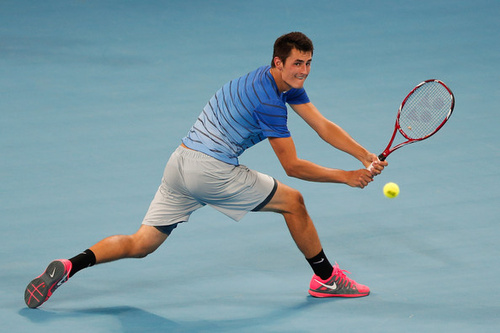Don't miss any stories → Follow Tennis View
FollowAussie Prodigy Bernard Tomic Faces a Crossroads
Twenty-one is a peculiar age in professional sport. By then, the world expects the individual athlete to be a ready-made role model. In reality, athletes spend their developing years in a spotlight that is fickle at the best of times. On the ATP circuit, the age of 21 can also be the crossroads where a career soars or sinks. While many players have successfully made the transition from prodigal teen to professional journeyman, just as many of similar talents have fallen through the gap and have struggled to find themselves on Tour. Bernard Tomic is one such player who has experienced great turbulence as he attempts to transition successfully from his teenage years into a mature competitor and person.
The polarizing Australian, who turned 21 this week, has yet to give the tennis world a clear indication of the trajectory that his career will take. His skills suggest that he is a talent capable of heading in the direction of the top 10. On the other hand, the instability within his team and his often rash demeanor toward the media indicate that his career has the potential to plummet as far as it can skyrocket.

Players who have defined this sport often have announced their arrival onto the world stage at the age where Tomic finds himself now. Swiss legend Roger Federer won his first Masters 1000 title as well as his first major title (Wimbledon 2003) at 21. Six-time major champion Novak Djokovic won his first major months before his 21st birthday, and WTA world No. 1 Serena Williams began to consistently win majors at 21 despite breaking through for her first US Open title at just 17. Comparing Tomic to such legends is unfair at this stage. But his raw talents on the tennis court rank among the finest of his generation, even if his results have not shown it.
Similarly, a significant group of players have failed to translate impressive results from their younger years into tournament wins on the ATP Tour. Donald Young is a notable example, as are other former junior champions at majors, ranging from Thiemo de Bakker in the men’s game to Barbora Zahlavova Strycova among the women. Some players may find the atmosphere intimidating, surrounded by equally talented peers and determined coaches hungry for success on the big stage. There is no clear answer in how to bridge the gap, but perhaps the solution for Tomic lies in the team-oriented competitions that other emerging talents have used to their advantage in the past.
Tomic’s well-documented friction with the Australian Davis Cup team and Captain Patrick Rafter reveal a young player who struggles to work within a team environment and a team structure. And yet the team competition path is how many young talented players have managed to gain the mindset to adjust to life on the tour. The undisputed men’s top three of the last decade, Federer, Djokovic and Rafael Nadal, all used team competitions to their advantage. They regularly participated in events such as the Davis Cup and Hopman Cup. Their characters surely were strengthened by playing in a team environment where they gained the experience interacting with senior coaches and other players.
Granted, Federer rarely participates in team events as a mature player, but such was not the case during his formative period. Before he became an international superstar, Federer won the Hopman Cup for Switzerland with fellow countrywoman Martina Hingis in 2001 and also appeared at the Hopman Cup again in 2002. Similarly, Djokovic continues to play the tournament in Perth as part of his Australian Open warm-up, and both he and Nadal regularly have committed throughout their careers to play each tie at the Davis Cup. One of Nadal’s key breakthroughs came in 2004 at the age of 18 when he defeated Andy Roddick in a crucial rubber of the Davis Cup final. The Spaniard would not claim his stranglehold over Roland Garros until the following year, but that victory in Seville proved as pivotal as any in igniting his career. Meanwhile, Djokovic's central role in securing Serbia's first Davis Cup title in 2010 catalyzed his spectacular dominance a year later, the best season of his career so far.
To turn the tables on his continually sputtering career, Tomic would be wise to put his hand up for each and every Davis and Hopman Cup tie, not only to represent his country but to perhaps fix a number of individual physical and mental flaws.
With the ebb-and-flow nature of the ATP Tour, this age landmark is by no means the final crossroads of Tomic’s career. But one feels that, should he endure another year of modest results and personal turmoil, he will fall further behind where he needs to be to reach the level where he belongs.










